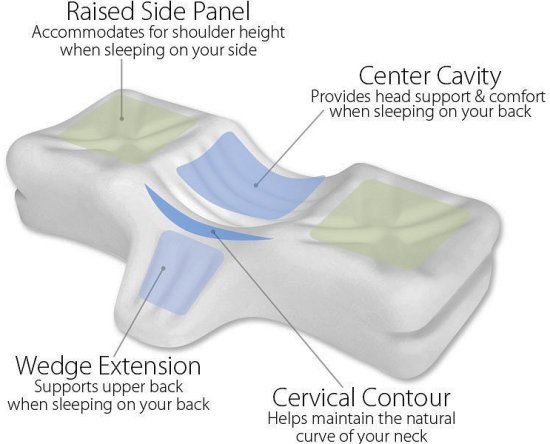A Unique Spinal Therapy Pillow Which Is Designed To Adequately Support The Cervical And Upper Thoracic Spine & Head Whenever Back Sleeping & Side Sleeping
This is truly a distinct spinal therapy pillow that is made to correctly support the head, neck, upper back, and shoulders while back and side sleeping. Most people sleep in the center of the pillow if they sleep on their backs and the center of this pillow is designed particularly for back sleeping having a specialized wedge intended for upper back assistance. While side sleeping, the exterior edges of the pillow are created to support the head, neck and shoulders with additional height.
The special density of the pillow foam results in a combination of flexibility and firmness that allows for a therapeutic advantage, resulting in a unique approach to getting more comforting, yet vital supporting sleep for neck pain sufferers.
Because most individuals sleep at night either on their sides and their backs, these types of positions call for distinct support to maintain correct neck positioning. The head ought to be supported approximately 2 " higher in the side position than in the back position. Trying to make this correction, you might find yourself placing your hands beneath a pillow while sleeping on ones side. This means that you will need additional support in the side position to accommodate shoulder width and the spinal therapy pillow delivers a unique level of support not found in most cervical pillows.
Although the basic design is now often copied, lack of sizing and different materials used like memory foam do not permit the proper level of support and will shift over time, thus defeating the purpose of an ergonomic consistency for therapeutic benefit.
As a result of distinct sleeping regions noted in a functional pillow, you should be aware of the way you modify positions using the pillow. You will not want to sleep on your back in the areas intended for side sleeping. Consequently, a mindful effort is necessary to change positions. This is usually no problem having acute conditions like neck sprain, strain, whiplash or neck injuries, and arthritic flare-ups.
In the back sleeping position, the head not only should be supported at the correct height, yet kept from tilting forward and constraining airways, or from moving laterally which can place rotational strain on the neck leading to muscle tenderness and joint pain. Proper upper thoracic spinal assistance is also advisable in order to avoid the weight from the body from taking the cervical spine out from alignment and allow the pillow to form a biomechanical advantage from the head, neck and upper back areas.
Spinal Therapy Pillow Sizes
From kids 6 and up to larger adults, you will find the perfect size by taking a simple measurement from the side of the neck to the outside of the shoulder bone. This assures correct spinal alignment for your particular body type, size and shape.
Available In: Kids (up to 4¼") | Petite (4¼" to 5¼") | Standard (5¼" to 6¼") | Large (6¼" to 7¼") Extra Large – Over 7¼"
How To Measure For A Pillow That Provides The Best Fit
Established Benefits of Pillows For Neck Pain
Here’s a unique pillow which is designed to provide therapy while you sleep by adequately supporting the neck and head whenever back sleeping and side sleeping. Many people sleep in the heart of their pillow every time they sleep on their backs, the center of this pillow is intended specifically for back sleeping having a distinctive wedge for upper back support. If side sleeping, the exterior edges of this pillow are designed to assist the neck and shoulder with additional height, along with clearance using a curved shape for the shoulder to keep the thoracic spine from torsion stress.
If you sleep on your stomach, you require a special type of pillow for stomach sleepers to reduce torsion on cervical spine muscles, ligaments, discs and joints. However, since the majority of people sleep both on their sides in addition to their backs, these types of positions call for distinctive support to help maintain correct neck positioning. Your head needs to be supported approximately 2″ higher on the side position when compared to the back position. Attempting to make this correction, you may find yourself placing your hands beneath a pillow if sleeping on ones side. This suggests you’ll need additional support in this position and the spinal therapy pillow offers this kind of assistance.
As a result of different sleeping areas, you’ll need to be aware of how you adjust positions when using the pillow. You do not want to rest lying on your back within the areas for side sleeping. So, a mindful effort is necessary to change positions. Therefore, this pillow may be used when your neck is in particular pain. As the pain subsides, you can switch back to a uniform surface pillow. This can be a part of a strategy to manage neck pain with pillows.
Higher levels of pain necessitate that while in the back sleeping position, your head not only must be supported at the proper height, but stopped from tilting forward and limiting airways, as well as from moving from side to side which could put rotational strain on the neck contributing to muscle tightness and joint pain. Upper back spinal assistance is also desired to stop lower body weight from the body from pulling your neck out the optimal biomechanical alignment.
More Details & Videos On This Special Therapy Pillow
A 2020 study indicates this type of spinal therapy pillow uses sleep related factors required to address problems like reducing neck fatigue and shoulder pain and uses practical guides for for better pillow design.


